Related Research Articles

Cryolite (Na3AlF6, sodium hexafluoroaluminate) is an uncommon mineral identified with the once-large deposit at Ivittuut on the west coast of Greenland, mined commercially until 1987.

Scolecite is a tectosilicate mineral belonging to the zeolite group; it is a hydrated calcium silicate, CaAl2Si3O10·3H2O. Only minor amounts of sodium and traces of potassium substitute for calcium. There is an absence of barium, strontium, iron and magnesium. Scolecite is isostructural (having the same structure) with the sodium-calcium zeolite mesolite and the sodium zeolite natrolite, but it does not form a continuous chemical series with either of them. It was described in 1813, and named from the Greek word, σκώληξ (sko-lecks) = "worm" because of its reaction to the blowpipe flame.
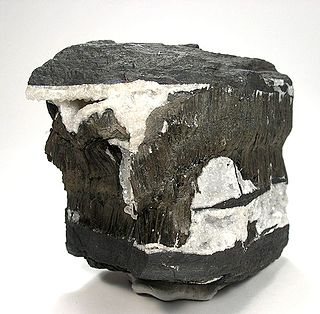
Todorokite is a complex hydrous manganese oxide mineral with generic chemical formula (Na,Ca,K,Ba,Sr)
1-x(Mn,Mg,Al)
6O
12·3-4H
2O. It was named in 1934 for the type locality, the Todoroki mine, Hokkaido, Japan. It belongs to the prismatic class 2/m of the monoclinic crystal system, but the angle β between the a and c axes is close to 90°, making it seem orthorhombic. It is a brown to black mineral which occurs in massive or tuberose forms. It is quite soft with a Mohs hardness of 1.5, and a specific gravity of 3.49 – 3.82. It is a component of deep ocean basin manganese nodules.

Chloritoid is a silicate mineral of metamorphic origin. It is an iron magnesium manganese alumino-silicate hydroxide with formula (Fe, Mg, Mn)
2Al
4Si
2O
10(OH)
4. It occurs as greenish grey to black platy micaceous crystals and foliated masses. Its Mohs hardness is 6.5, unusually high for a platy mineral, and it has a specific gravity of 3.52 to 3.57. It typically occurs in phyllites, schists and marbles.

Zanazziite is a complex hydrated phosphate mineral from the roscherite group. It is a magnesium beryllium phosphate mineral. Zanazziite arises as barrel-shaped crystals and can reach up to 4 mm. It grows alongside quartz minerals. It is found in the crevices of Lavra da Ilha pegmatite, near Taquaral, in northeastern Minas Gerais, Brazil. Zanazziite is named after Pier F. Zanazzi. Zanazziite has an ideal chemical formula of Ca2Mg5Be4(PO4)6(OH)4·6H2O.
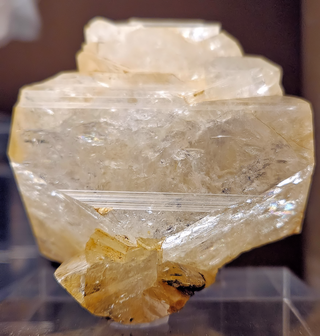
Hyalophane or jaloallofane is a crystalline mineral, part of the feldspar group of tectosilicates. It is considered a barium-rich potassium feldspar. Its chemical formula is (K,Ba)[Al(Si,Al)Si2O8], and it has a hardness of 6 to 6+1⁄2. The name hyalophane comes from the Greek hyalos, meaning "glass", and phanos meaning "to appear".

Partheite or parthéite is a calcium aluminium silicate and a member of the zeolite group of minerals, a group of silicates with large open channels throughout the crystal structure, which allow passage of liquids and gasses through the mineral. It was first discovered in 1979 in rodingitic dikes in an ophiolite zone of the Taurus Mountains in southwest Turkey. The second discovery occurred in gabbro-pegmatites in the Ural Mountains, Russia. Since its discovery and naming, the chemical formula for partheite has been revised from CaAl2Si2O8·2H2O to include not only water but hydroxyl groups as well. The framework of the mineral is interrupted due to these hydroxyl groups attaching themselves to aluminum centered oxygen tetrahedra. This type of interrupted framework is known in only one other zeolite, the mineral roggianite. As a silicate based mineral with the properties of a zeolite, partheite was first described as zeolite-like in 1984 and listed as a zeolite in 1985. Partheite and lawsonite are polymorphs. Associated minerals include prehnite, thomsonite, augite, chlorite and tremolite.

Huttonite is a thorium nesosilicate mineral with the chemical formula ThSiO4 and which crystallizes in the monoclinic system. It is dimorphous with tetragonal thorite, and isostructual with monazite. An uncommon mineral, huttonite forms transparent or translucent cream–colored crystals. It was first identified in samples of beach sands from the West Coast region of New Zealand by the mineralogist Colin Osborne Hutton (1910–1971). Owing to its rarity, huttonite is not an industrially useful mineral.
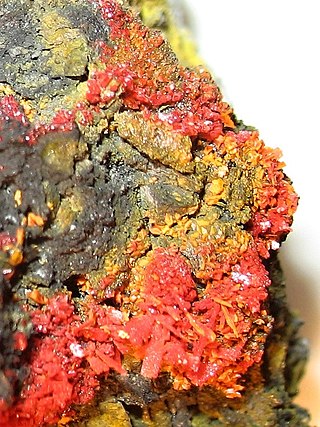
Alacránite (As8S9) is an arsenic sulfide mineral first discovered in the Uzon caldera, Kamchatka, Russia. It was named for its occurrence in the Alacrán silver/arsenic/antimony mine. Pampa Larga, Chile. It is generally more rare than realgar and orpiment. Its origin is hydrothermal. It occurs as subhedral to euhedral tabular orange to pale gray crystals that are transparent to translucent. It has a yellow-orange streak with a hardness of 1.5. It crystallizes in the monoclinic crystal system. It occurs with realgar and uzonite as flattened and prismatic grains up to 0.5 mm across.

Vlasovite is a rare inosilicate (chain silicate) mineral with sodium and zirconium, with the chemical formula Na2ZrSi4O11. It was discovered in 1961 at Vavnbed Mountain in the Lovozero Massif, in the Northern Region of Russia. The researchers who first identified it, R P Tikhonenkova and M E Kazakova, named it for Kuzma Aleksevich Vlasov (1905–1964), a Russian mineralogist and geochemist who studied the Lovozero massif, and who was the founder of the Institute of Mineralogy, Geochemistry, and Crystal Chemistry of Rare Elements, Moscow, Russia.

Tsumcorite is a rare hydrated lead arsenate mineral that was discovered in 1971, and reported by Geier, Kautz and Muller. It was named after the TSUMeb CORporation mine at Tsumeb, in Namibia, in recognition of the Corporation's support for mineralogical investigations of the orebody at its Mineral Research Laboratory.
Paulscherrerite, UO2(OH)2, is a newly named mineral of the schoepite subgroup of hexavalent uranium hydrate/hydroxides. It is monoclinic, but no space group has been determined because no single-crystal study has been done. Paulscherrerite occurs as a canary yellow microcrystalline powdery product with a length of ~500 nm. It forms by the weathering and ultimate pseudomorphism of uranium-lead bearing minerals such as metaschoepite. The type locality for paulscherrerite is the Number 2 Workings, Radium Ridge near Mount Painter, North Flinders Ranges, South Australia, an area where radiogenic heat has driven hydrothermal activity for millions of years. It is named for Swiss physicist Paul Scherrer, co-inventor of the Debye-Scherrer X-ray powder diffraction camera. Study of paulscherrerite and related minerals is important for understanding the mobility of uranium around mining sites, as well as designing successful strategies for the storage of nuclear weapons and the containment of nuclear waste.
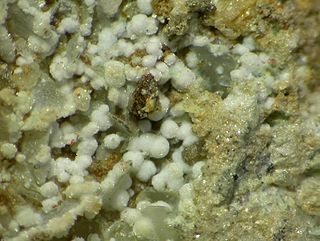
Brianyoungite is a secondary zinc carbonate mineral. The Commission on New Minerals, Nomenclature and Classification (CNMNC) of the International Mineralogical Association (IMA) classifies it as a carbonate with the formula Zn3(CO3)(OH)4, but sulfate groups SO4 also occupy the carbonate CO3 positions, in the ratio of about one sulfate to three carbonates, so other sources give the formula as Zn3(CO3,SO4)(OH)4, and Gaines et al. classify the mineral as a compound carbonate. It is similar in appearance to hydrozincite, another zinc carbonate. It was discovered in 1991 and designated IMA1991-053. In 1993 it was named "brianyoungite" after Brian Young (born 1947), a field geologist with the British Geological Survey, who provided the first specimens.

Köttigite is a rare hydrated zinc arsenate which was discovered in 1849 and named by James Dwight Dana in 1850 in honour of Otto Friedrich Köttig (1824–1892), a German chemist from Schneeberg, Saxony, who made the first chemical analysis of the mineral. It has the formula Zn3(AsO4)2·8H2O and it is a dimorph of metaköttigite, which means that the two minerals have the same formula, but a different structure: köttigite is monoclinic and metaköttigite is triclinic. There are several minerals with similar formulae but with other cations in place of the zinc. Iron forms parasymplesite Fe2+3(AsO4)2·8H2O; cobalt forms the distinctively coloured pinkish purple mineral erythrite Co3(AsO4)2·8H2O and nickel forms annabergite Ni3(AsO4)2·8H2O. Köttigite forms series with all three of these minerals and they are all members of the vivianite group.
The mineral khmaralite is a beryllium bearing mineral of the sapphirine group with a chemical formula of (Mg,Al,Fe)16[(Al,Si,Be)12O36]O40. It is most associated with sillimanite, surinamite, musgravite, garnet, and biotite. The known color is a dark greenish blue or a dark green, with a colorless streak. It is transparent with a vitreous luster with no cleavage and a Moh's hardness of 7. It is brittle with an uneven fracture. The calculated density is 3.61 g/cm3.

Tumchaite, Na2(Zr,Sn)Si4O11·H2O, is a colorless to white monoclinic phyllosilicate mineral. It is associated with calcite, dolomite, and pyrite in the late dolomite-calcite carbonatites. It can be transparent to translucent; has a vitreous luster; and has perfect cleavage on {100}. Its hardness is 4.5, between fluorite and apatite. Tumchaite is isotypic with penkvilksite. The structure of the mineral is identified by silicate sheets parallel {100}, formed by alternation of clockwise and counterclockwise growing spiral chains of corner-sharing SiO4 tetrahedra. Tumchaite is named for the river Tumcha near Vuoriyarvi massif.
Scotlandite is a sulfite mineral first discovered in a mine at Leadhills in South Lanarkshire, Scotland, an area known to mineralogists and geologists for its wide range of different mineral species found in the veins that lie deep in the mine shafts. This specific mineral is found in the Susanna vein of Leadhills, where the crystals are formed as chisel-shaped or bladed. Scotlandite was actually the first naturally occurring sulfite, which has the ideal chemical formula of PbSO3. The mineral has been approved by the Commission on New Minerals and Mineral Names, IMA, to be named scotlandite for Scotland.
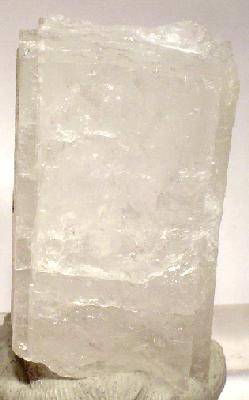
Chiolite is a tetragonal-ditetragonal dipyramidal mineral, composed of sodium, fluorine, and aluminium. The name originates from the combination of the Greek words for snow (χιώυ) and stone (λίθος). It is an allusion to its similarity and appearance to cryolite. Chiolite is an IMA approved mineral that has been grandfathered, meaning the name chiolite is believed to refer to a valid species to this day. Synonyms of chiolite are arksudite, arksutite, chodneffite, chodnewite and nipholith. It was first discovered in the Ilmen mountains, Russia, in 1846. Chiolite has been a valid species from the same year of its discovery.
Elgoresyite, first discovered during the crystallographic study of the Suizhou meteorite, is a naturally occurring, high-pressure iron-magnesium silicate mineral. High-pressure poly morphs of magnesium silicates have been rarely discovered on Earth, due to retrograding as they ascend to the surface. It is named after Ahmed El Goresy.
References
- ↑ Warr, L.N. (2021). "IMA–CNMNC approved mineral symbols". Mineralogical Magazine. 85 (3): 291–320. Bibcode:2021MinM...85..291W. doi: 10.1180/mgm.2021.43 . S2CID 235729616.
- 1 2 3 4 5 6 7 8 Foord, E., et al., 1999, Simmonsite Na 2 Li Al F 6, a new mineral from the Zapot amazonite-topaz-zinnqaldite pedmatite, Hawthorne, Nevada, U.S.A.: American Mineralogist, v.84 p.769-772.
- 1 2 Hudson Institute of Mineralogy, 2017, Simmonsite: http://www.mindat.org/min-7297.html (accessed November 2017)